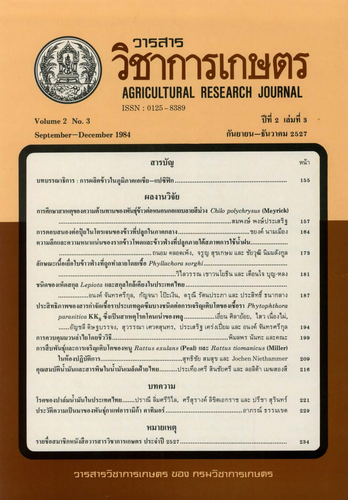การตอบสนองต่อปุ๋ยไนโตรเจนของข้าวที่ปลูกในภาคกลาง
บทคัดย่อ
ได้ดำเนินการทดลองศึกษาอิทธิพลของดินนาชนิดต่าง ๆ ต่อความสามารถในการให้ผลผลิตและตอบสนองต่อปุ๋ยของข้าวในภาคกลางของประเทศ ทั้งในฤดูฝนและฤดูแล้ง ระหว่างปี พ.ศ. 2519 ถึง 2526 โดยจัดแบ่งดินนาที่ใช้ในการทดลองเป็น 4 ประเภท ตามลักษณะและคุณสมบัติของดินบน ชั้นไถพรวน (0-15 ซม.) คือ ดินเหนียว (Aeric และ typic Tropaqualfs) ดินร่วนปนดินเหนียว (Aeric Tropaquepts และ Aeric tropaqualfs) ดินร่วนเหนียวปนทราย (Aeric Plinthic Tropaqualfs) และดินเหนียวเปรี้ยว (Typic Tropaquepts) ใช้พันธุ์ข้าวไม่ไวต่อช่วงแสง ไวต่อช่วงแสงเล็กน้อย และไวต่อช่วงแสง ในการศึกษาร่วมกับปุ๋ย N อัตราต่าง ๆ ตั้งแต่ 0-36 กก. N/ไร่ โดยใส่ปุ๋ยฟอสเฟตและโปแตส ในอัตราระหว่าง 3 ถึง 6 กก. ของ P2O5 และ K2O5/ไร่ ก่อนปักดำ เป็นปุ๋ยรองพิ้น ทั้งนี้เพื่อหาอัตราปุ๋ย N ที่เหมาะสมที่สามารถให้ผลผลิตข้าวสูงสุด หรือให้ผลผลิตข้าวสูงพร้อมกำไรสูงสุด
ผลการทดลอง ปรากฎว่าการตอบสนองต่อปุ๋ย N ของข้าวขึ้นอยู่กับชนิดของดินและพันธุ์ข้าว การให้ผลผลิตสูงของข้าวที่ปลุกในดินนาชนิดต่าง ๆ เรียงลำดับจากมากไปหาน้อย คือ ดินเหนียว ดินร่วนปนดินเหนียว ดินร่วนเหนียวปนทรายและดินเหนียวเปรี้ยว อย่างไรก็ตาม ในดินชนิดเดียวกัน ข้าวที่ปลูกในฤดูแล้งมีความสามารถในการตอบสนองต่อปุ๋ย N ได้สูงกว่า และให้ผลผลิตได้สูงกว่าข้าวที่ปลูกในฤดูฝน ปริมาณความต้องการปุ๋ย N ของข้าวเพื่อให้ผลผลิตสูงหรือสูงสุดเรียงลำดับจากน้อยไปหามาก คือ ดินเหนียว ดินร่วนปนดินเหนียว ดินร่วนเหนียวปนทราย และดินเหนียวเปรี้ยว ในฤดูฝน พันธุ์ข้าวไม่ไวต่อช่วงแสง , ไวต่อช่วงแสงเล็กน้อย และไวต่อช่วงแสง ให้ผลผลิตข้าวสูงสุด คือ 927 , 750 และ 714 กก. ข้าวเปลือก/ไร่ ประสิทธิภาพของปุ๋ย N ในการเพิ่มผลผลิตข้าวสำหรับพันธุ์ข้าวไม่ไวต่อช่วงแสงที่ปลูกในดินร่วนปนดินเหนียวและดินร่วนเหนียวปนทราย มีอัตราเพิ่ม 9.3-10.2 กก. ข้าวเปลือก/1 กก. N สำหรับพันธุ์ข้าวไวต่อช่วงแสงที่ปลูกในดินร่วนปนดินเหนียวและดินร่วนเหนียวปนทราย มีอัตราเพิ่ม 9.3-10.2 กก. ข้าวเปลือก/ฟ กก. N สำหรับพันธุ์ข้าวไวต่อช่วงแสงปลูกในดินร่วนเหนียวปนทรายและดินเหนียวเปรี้ยวมีอัตราเพิ่ม 9.3-9.7 กก. ข้าวเปลือก /1กก. N
ข้าวแสดงการตอบสนองต่อระดับปุ๋ย N ในลักษณะเพิ่มผลผลิตสูงสุดและลดน้อยถอยลง (Quadratic response) เพราะฉะนั้น อัตราปุ๋ยสำหรับผลผลิตข้าวสูงสุดและผลผลิตพอเหมาะทางเศรษฐกิจ (ผลผลิตข้าวสูงพร้อมกำไรสูงสุด) พร้อมทั้งปริมาณของผลผลิตข้าวที่จะได้รับสามารถคำนวณได้จากสมการ Quadratic ต่าง ๆ ของการตอบสนองของข้าวต่อระดับปุ๋ย N ในดินนาประเภทต่าง ๆ
ดาวน์โหลด
เผยแพร่แล้ว
รูปแบบการอ้างอิง
ฉบับ
ประเภทบทความ
สัญญาอนุญาต
วารสารวิชาการเกษตร



